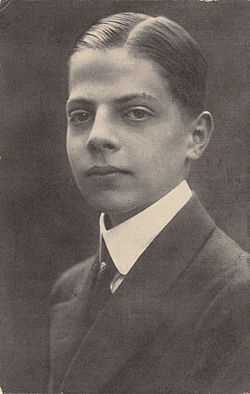Georg Moritz, Hereditary Prince of Saxe-Altenburg
| Georg Moritz | |||||
|---|---|---|---|---|---|
| Hereditary Prince of Saxe-Altenburg | |||||
 | |||||
| Head of the House of Saxe-Altenburg | |||||
| Reign | 1955–1991 | ||||
| Predecessor | Ernst II | ||||
| Successor | House Extinct | ||||
| |||||
| House | House of Saxe-Altenburg | ||||
| Father | Ernst II, Duke of Saxe-Altenburg | ||||
| Mother | Princess Adelaide of Schaumburg-Lippe | ||||
| Born |
13 May 1900 Potsdam, Prussia | ||||
| Died |
13 February 1991 (aged 90) Rendsburg, Germany | ||||
George Moritz, Hereditary Prince of Saxe-Altenburg (William George Moritz Ernest Albert Frederick Charles Constantine Edward Maximilian; 13 May 1900 – 13 February 1991), was the last head of the ducal house of Saxe-Altenburg and nominal Duke of Saxe-Altenburg. He devoted much of his life to promote anthroposophy.
Life
Born in Potsdam, Prussia, he was the eldest son of Prince Ernest of Saxe-Altenburg and Princess Adelaide of Schaumburg-Lippe, his first wife. At the time of his birth, his father, then the third-in-line to succeeded the Ducal throne, lived with his wife in Prussia as a Captain and commander of the 1st Regiment of Foot Guards in Potsdam. George Moritz and his three siblings where all born and lived there.
The death of his father Prince Moritz on 13 May 1907, made Prince Ernest the Hereditary Prince of Saxe-Altenburg, and nine months later (7 February 1908) with the death of his uncle Duke Ernest I he became in the new ruler of the Duchy of Saxe-Altenburg as Ernest II. Then, the whole family moved from Potsdam to Altenburg. George Moritz, now Hereditary Prince, lived at the Ducal court until March 1913, when his father send him to Dresden to continue his education at the King Georg High School (German: König-Georg-Gymnasium); in addition to this, he received his military training at the 8th Thuringian Infantry Regiment N°153.
After Germany lost World War I, Duke Ernest II was forced to abdicate the government of the Duchy on 13 November 1918, and spent the rest of his life like a private citizen. Two years later (17 January 1920) was formally pronounced the divorce between George Moritz' parents.
Already in his youth, George Moritz was interested in anthroposophy. Beginning of the 1930s, his meeting with Siegfried Pickert was a turning point in his life. His life since then centered around the Hamborn Castle, where he was actively involved as representative of the anthroposophic and teaching since 1931. In 1936 he rented the farm near the Castle.[1]
Although the Nazi regime banned the anthroposophy, the investigation with disabled children could be continued in Hamborn until June 1941, thanks to the mediation of George Moritz; he counted with the protection of Rudolf Hess who until 1941 was a supporter of the anthroposophy.[2] However, eventually the Gestapo stopped the investigations and George Moritz, with the managing director of the institution Adolf Ammerschläger where placed for nine and a half months in protective custody.
In 1946, George Moritz returned to Hamborn Castle, where he campaigned again for employees, guests of the convalescent home and especially for there living in the boarding school youth. Until 1968, he worked among other things, in the board of the local social charity. He lived modestly in a small apartment in the Castle, surrounded by an extensive library.
When his father died in 1955, George Moritz became the head of the house of Saxe-Altenburg and nominal Duke of Saxe-Altenburg. He never married and his only brother and heir presumptive, Frederick, died also unmarried in 1985.
On 13 February 1991 George Moritz died as a result of pneumonia in Rendsburg hospital. With his death the house of Saxe-Altenburg became extinct, although the family name continue due to the adoption in 1942 of Franz, Count Praschma by Princess Marie (6 June 1888 - 12 November 1947), second daughter of Prince Albert of Saxe-Altenburg.
The representation of the Ducal house was merged with that of Saxe-Weimar-Eisenach.
George Moritz was the godfather of German journalist Rolf Seelmann-Eggebert.[3]
References
- ↑ Die Pachtübernahme durch den Erbprinz von Sachsen-Altenburg in: Schloss Hamborn Chronik.de [retrieved 10 December 2014].
- ↑ Das Verbot durch die Nazis in: Schloss Hamborn Chronik.de [retrieved 10 December 2014].
- ↑ Dokumentation: Ein Abend für Rolf Seelmann-Eggebert. NDR 4. February 2012.
Ancestry
| Georg Moritz, Hereditary Prince of Saxe-Altenburg House of Saxe-Altenburg Cadet branch of the House of Wettin Born: 13 May 1900 Died: 13 February 1991 | ||
| Titles in pretence | ||
|---|---|---|
| Preceded by Ernst II |
— TITULAR — Duke of Saxe-Altenburg 1955–1991 Reason for succession failure: Duchy abolished in 1918 |
Extinct |